As a followup to the last post, I continue with the weaving portion of my trip to Amami.
On the way to Higo Dorozome Friday, I saw a sign that read “Oshima Tsumugi Village” so we decided to start there on Saturday. I didn’t realize until afterwards that this is where Jackie did her mud -dyeing workshop (we later compared notes). Since I had already done the sharimbai/dorozome workshop we opted for the basic tour and focused on weaving. They have a good but short tour of the weaving process but the real highlight was the addition of a weaving session on one of their looms where you could weave and keep a length of Oshima silk tsumugi. This was purchased at the beginning of the tour with the entrance fee.
Of course, the plain weaving of a piece of silk oshima tsumugi is a fairly basic process even for a novice. The real work as most weavers know, is in the preparation of the warp and the set-up of the loom. Oshima tsumugi takes this to new heights with its complicated pattern drafting, the precise dyeing of both the warp AND the weft threads prior to measuring and warping the loom. In addition, starch is also applied to the silk threads prior to “shim-bata” weaving as well as after the dyeing prior to warping. the starch or glue is made of specific types of local seaweed.
The process of dyeing the threads:
Prior to the late 1800’s, the threads were wrapped with banana plant fiber to resist the dye and form the kasuri patterns. Other methods, from various areas dyeing resisted threads for kasuri weaving, include tying and clamping the threads, but in 1907 two men from Amami in Kagoshima prefecture invented a new method. This consisted of weaving the warps and the wefts temporarily with cotton threads on a special shim-bata loom which resulted in more precise and complicated patterning as well as improvements in production quantity and quality.(The tightly woven cotton wefts over the silk warps resist the dye in shibori-like fashion.)
We saw the preparation of the warping threads-the weaving of the patterns from a precise draft of the pattern desired as well as the additional colored dyeing of the wefts post-dorozome dyeing. Apparently there are 28 (!)preliminary processes that take place in preparation of the actual weaving.
Once the loom is warped (we did not see that process) the weaving begins and the weaver takes over. The weaver handles the shuttles adeptly and quickly, stopping every 7-10 centimeters or so to adjust the threads with a sturdy needle and correct any errors in the pattern caused by tension issues, by adjusting the warp threads before continuing on.
I was sat at a loom and after a brief instruction in Japanese and (international hand waving) I wove about 20 centimeters of beautiful plain woven silk, alternating shuttles filled with a variety of solid and multi-colored silk bobbins. It was like magic! The finished piece was a simple striped pattern and the resulting cloth was very smooth and lightweight.
It really is amazing how the skills for this type of silk fabric came to be developed, practiced and cherished by the Japanese of Amami Oshima and beyond. You can really appreciate the very high prices of this fine silk cloth once you have seen it first-hand. You can read about it, see photos & videos, but to experience it first hand- even for a short time is precious. One of the weavers told me she had been weaving for over 40 years. She said that anyone could do it but that it takes 4 years of 8 hours a day weaving to achieve the correct quality as a weaver of oshima tsumugi. I actually thought that might be understated. I told her I have a lot of catching up to do!
The whole process is such a team effort and the failure of the materials or quality at any point in the process has the potential to ruin the work of all the prior steps taken by the other artisans to that point. Everyone is very focused on a good outcome.
A couple of other points to note- the silk used is not filature silk, meaning that it is not reeled from the cocoon. It is referred to as a yarn, meaning that it is spun from a silk like mawata.
Apparently, sericulture was (is?) practiced on the island but I did not get to see any of that this time. Further research ahead…
I’m interested in seeing how the silk used for the Amami oshima tsumugi is spun and prepared for weaving here, who does it, and where.
Another note- during our tour of the tsumugi village, our guide/driver Kounosuke tells us that his mother was a weaver on the island before she had children (4). AND that his grandfather was a dyer….he has lived on Amami his entire life and had not seen the weaving process before.
About the guided tour at the Amami Oshima Village:
If you are not there to do a workshop, the tour seems quite rushed. They have a specific amount of time devoted to each group before ushering them into the gift shop. I get the impression that there are a lot of casual tourist that go through there by the busloads in the high season. The gift shop does have two parts- the VERY expensive side featuring full kimono, full bolts of woven silk, obi, and various other very fine clothing items and also another side which is filled with fine but more affordable and smaller items- all beautiful and interesting to see.
Kounosuke told us that the high season is of course Golden Week, July and August (when school is out and workers have vacation time) as well as during the Hatchi-matsuri or August festival. He said that was his favorite holiday of the year in Amami. Our other guide who did speak English was Yui who grew up in Yokohama (!)and came to live in Amami one year ago after visiting it on vacation. It’s that kind of place.
Here is a photo gallery from the tour:

meet our friendly local tour guides- Kounosuke and Yui! Without them, we would have been lost! 
warm and tropical, Amami has lots of beautiful and lush vegetation 
silk hanging in the tour waiting room 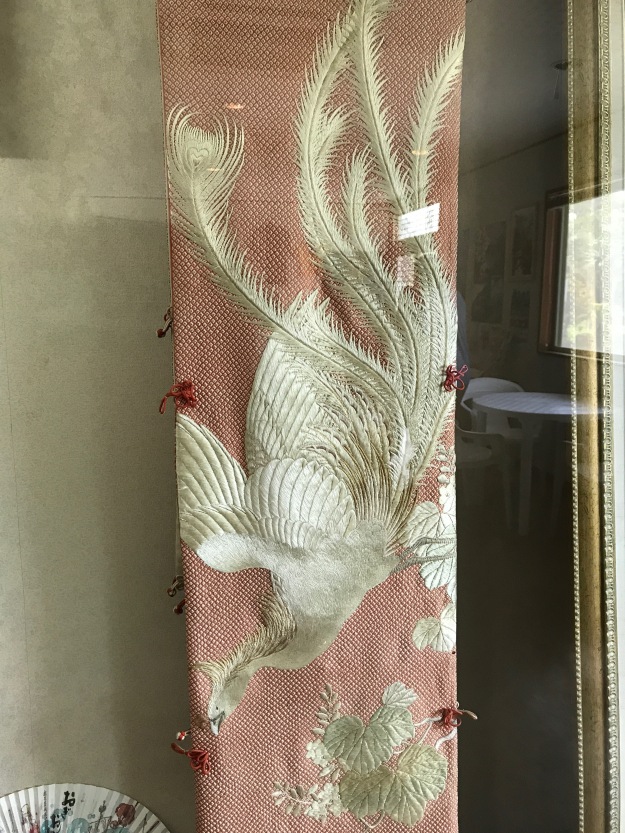
this amazing piece was there too but I have no idea what it’s significance was. 
balls of tsumugi silk ready for weaving I presume. 
the mud pit… 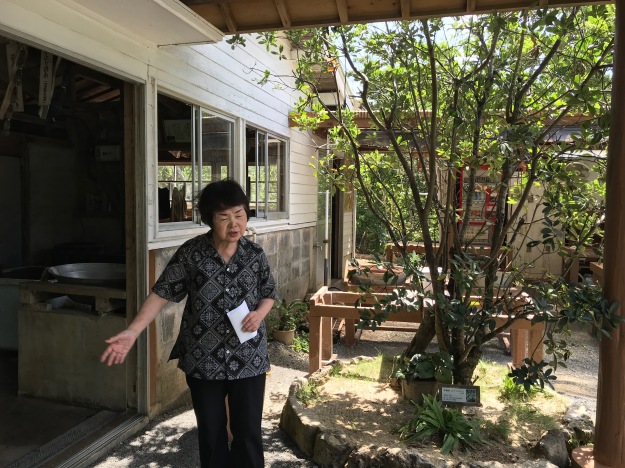
our tour guide explains the dyeing process- Japanese hawthorne tree in the background 
panorama of dyeworks 
showing the color based on number of dips into the sharimbai bath 
again- up to 80 dips before the mud bath 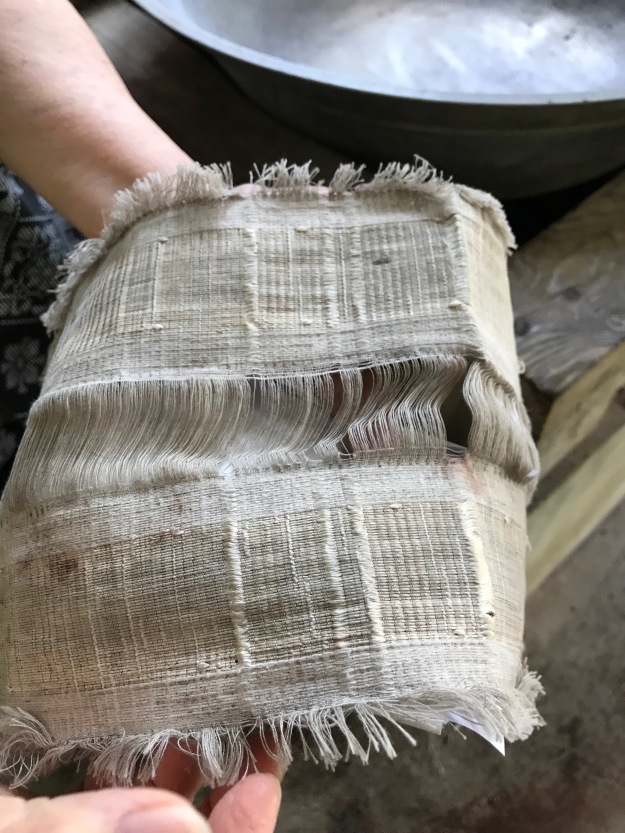
the woven kasuri mat before the dyeing 
dyed silk thread after the cotton thread is removed 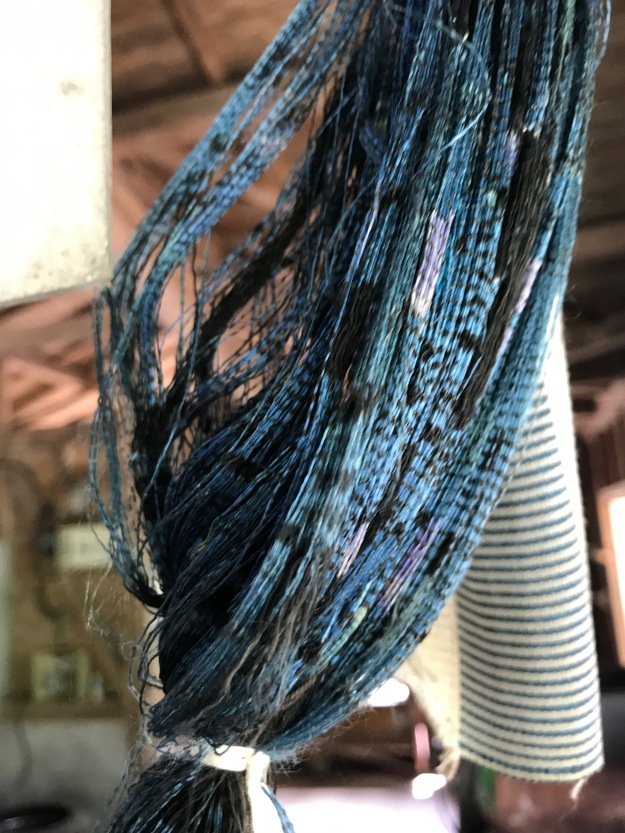
ore but with an overdye of indigo 
into the mud pit it goes 
the sample dyed was obviously done previously and for the tour he re-dips it into the mud 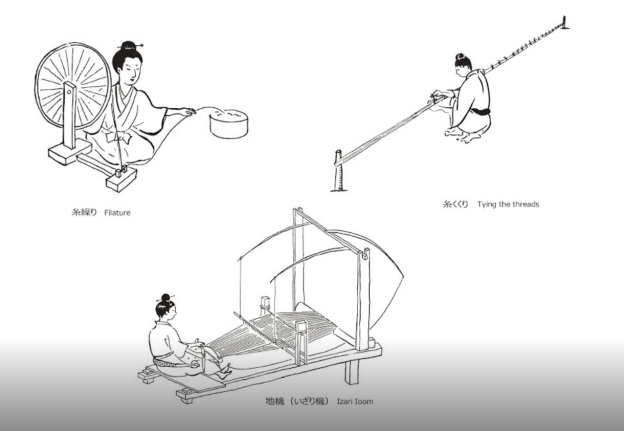
older method of wrapping the warp threads by hand binding prior to weaving 

weaving the kasuri mat on the shim-bata loom 
process explanation cards-English is a bit confusing on some but you will get the idea. 


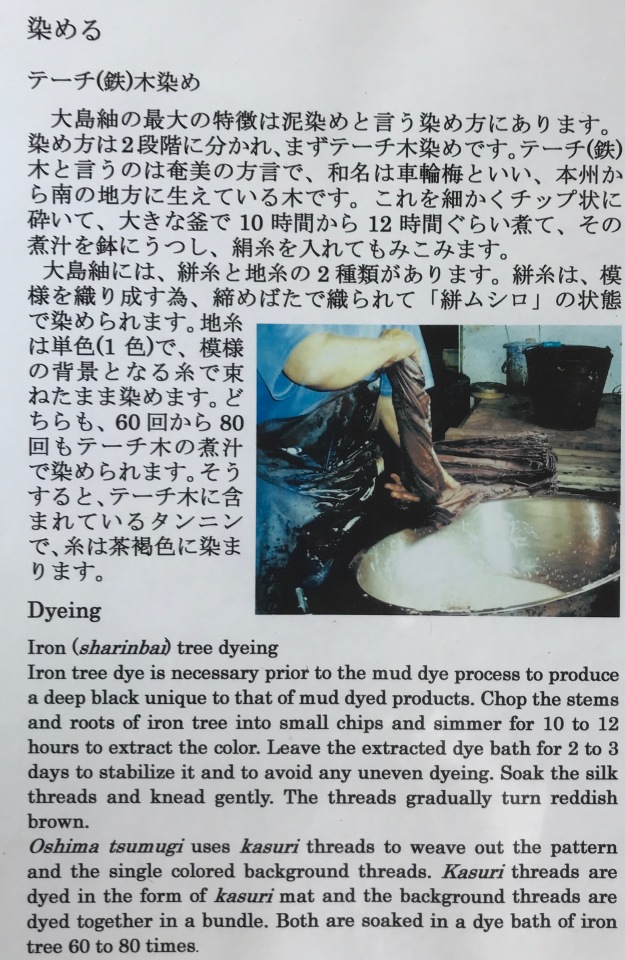


the kasuri mat after some threads have been removed and dyed with colored chemical dyes- 



here, the additional colors are applied as needed per design 
so much work already just to this point! 

cotton threads removed for dyeing detail 


trademarks 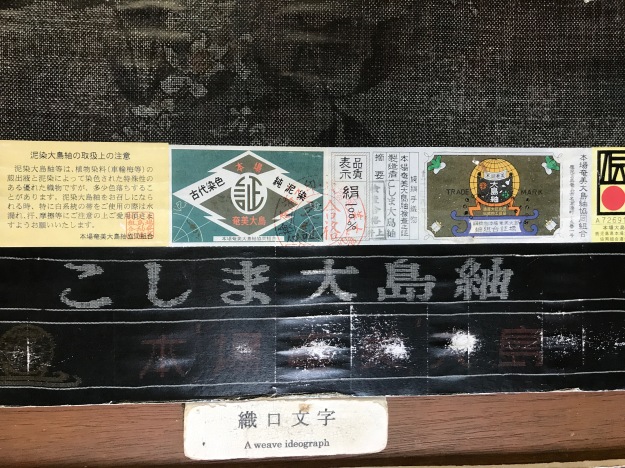
pattern 
more trademarks 
more colored threads ready for weaving 
this is probably the most well known pattern 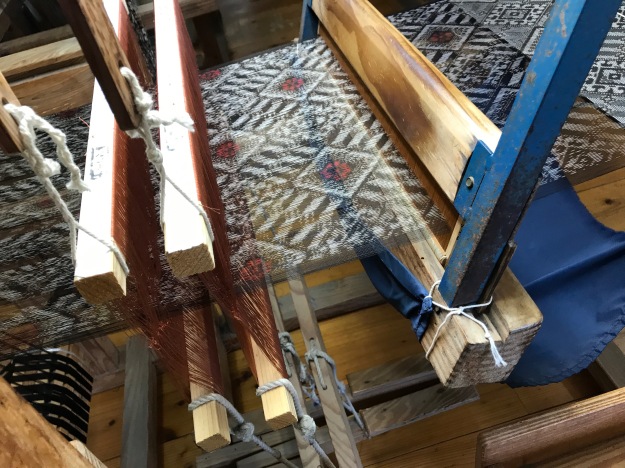
the pattern can be distinctly seen in the fine silk warp 
warping beam wrapped 
shuttle and bobbin 
the weaver takes over 
near perfection required before it goes to the cooperative where the inspection takes place and the cloth can be marked with the trademark assuring top quality 
you gotta eat sometime! raw chicken sashimi 
the famous Keihan of Amami for lunch- it lived up to its reputation
As before- there is a lot of video to edit so perhaps on the plane I will do some of it. To follow, the rest of the day tripping around Amami and then time traveling again back to Kyoto.
Other online resources:
https://artsandculture.google.com/exhibit/KQIy7n8uomYiIQ
this site gives a very good explanation of the tsumugi dyeing and weaving process by Kyoto Women’s University
https://kogeijapan.com/locale/en_US/honbaoshimatsumugi/

What beautiful pictures! How I wish I was there!
LikeLiked by 1 person
i hope one day you get there…
LikeLike
Many years ago, when my husband was on an invitational lecture tour in Japan, I was treated with a visit to Amami. Though not a weaver, but a stitcher and embroiderer, and even on just a brief “courtesy” tour, I could tell how complex the process was, and the small piece of weaving I purchased is precious. Thank you so much for your explanations and photos of the process – my small piece is even more precious, and I would love to revisit!
LikeLiked by 1 person
I’m thinking of putting together a tour of Amami and maybe one other place, maybe Nagoya and surrounding for a small group of vetted travelers. There is a really interesting history there on Amami on many accounts. I think you’d find Amami pretty much the way you left it, which is cool.
LikeLike
Thank you again Glennis for sharing your fabulous experiences via your blog. Your descriptions and photos allow me to “almost” be there too. The complexity of the whole process involving various people with their specialised skills and knowledge and the time involved to create a finished beautiful piece is awe inspiring. What a treat to learn about Amami-Oshima Tsumugi weaving.
LikeLike
I know it was a very long post but hard to get across the complexity of it without all the details. Amami was a fascinating place!
LikeLike
so much to absorb!
LikeLiked by 1 person
just so much…i will nibble on this for a very long time.
LikeLike